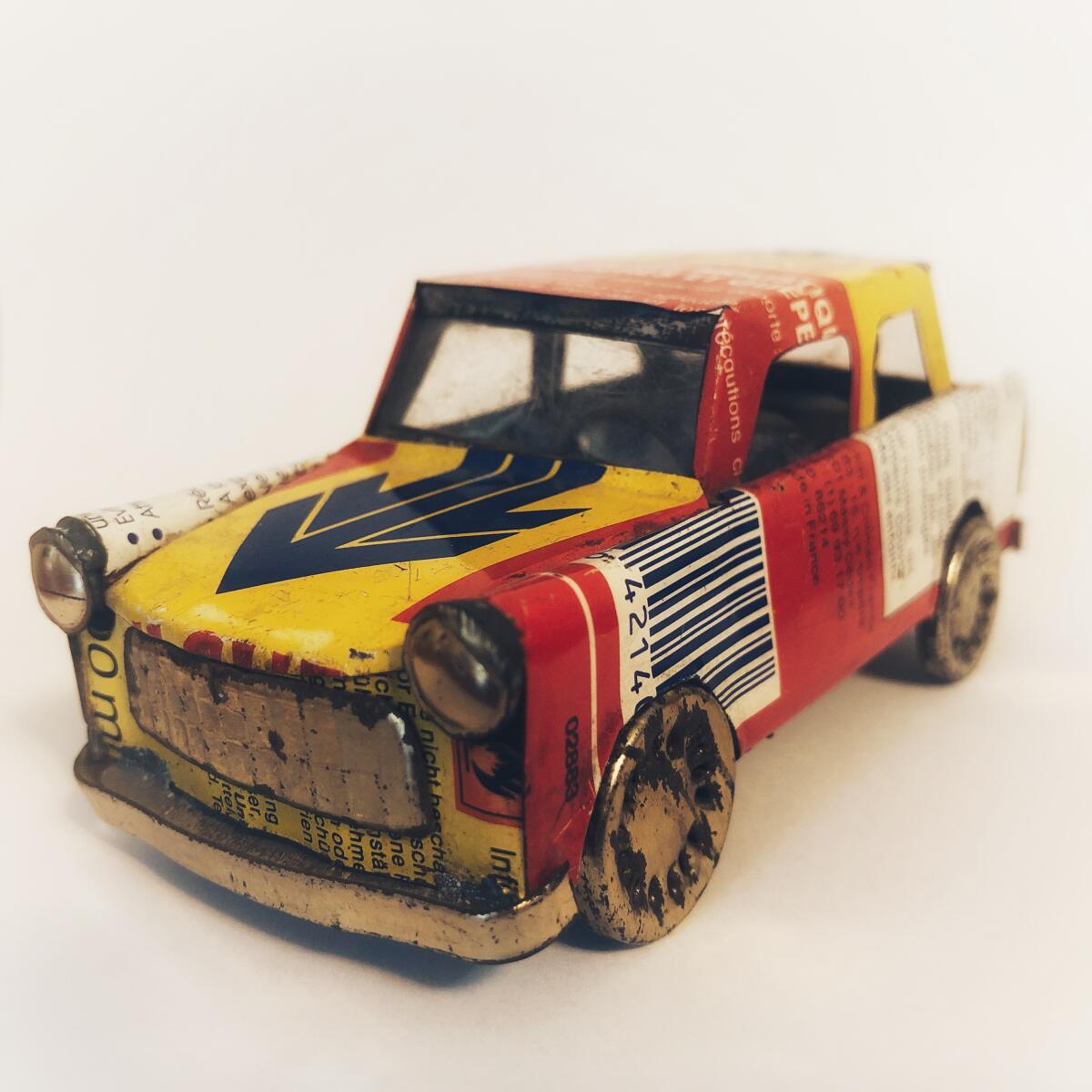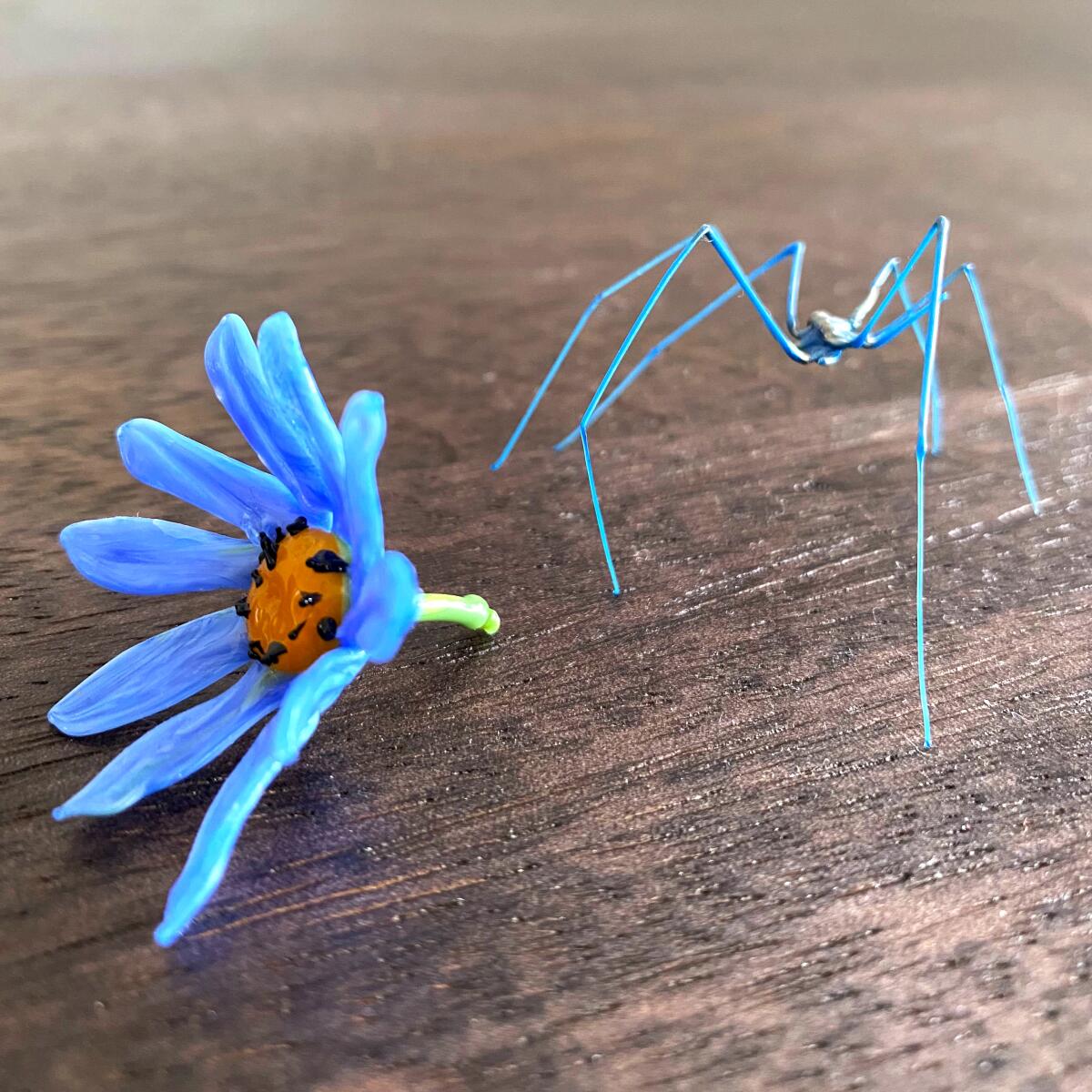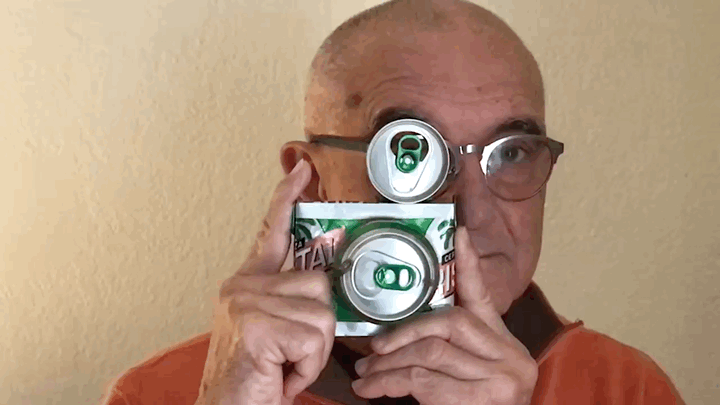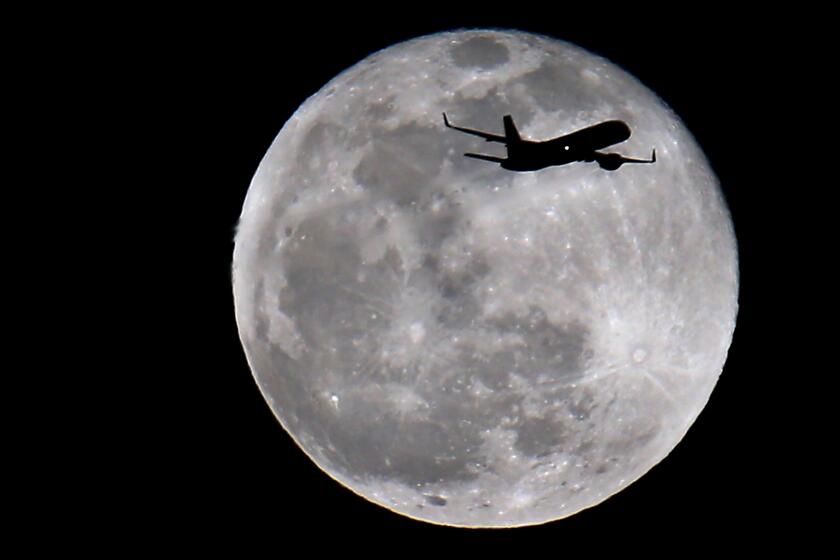Your favorite souvenirs: Readers share their wildest and wackiest travel keepsakes

- Share via
The artifacts below are souvenirs we love, some for obvious reasons, some for associated memories known to only to ourselves. We asked readers to share (and added a few from Times staffers) because this seems like a good time to remind ourselves of where we’ve been. Here are some of our favorite souvenirs and their stories.
Goat bells, Samothrace, Greece, 2019. The northern Aegean island of Samothrace has 3,000 people and 45,000 goats. It is a dream destination if hanging out on a beach, eating great fish and cheeses (and, um, lots of roast goat) or exploring the ruins of an ancient cult temple sounds like a good time to you.
I would wake early to listen to the waves and the sound of bells worn by a nearby herd of goats. So peaceful. I wanted to capture the sound if I could. I asked a staff member at our hotel where I could buy some. She thought long and hard, then called her father.
As U.S. faces its most trying coronavirus pandemic days, industry leaders imagine the future of travel.
As it turns out, the only source of goat bells on Samothrace is goatherds, who often make the bells themselves and attach them to the goats with olive-wood collars. By the end of the day, I was the proud owner of three well-weathered bells attached to handmade wooden collars. They smelled of the grassy warmth of livestock, and one still had a tuft of goat fur stuck in it!
—Sarah Schafer
Guitar, England, 2018. My favorite YouTube channel, Crimson Custom Guitars, features a tough-looking, much-tattooed master luthier building bespoke guitars and explaining his craft. I learned that he takes on students, so I decided to treat myself to the experience of a lifetime for my birthday (it was a big one). The family and I headed to the one-pub village of Piddlehinton, deep in the countryside of Dorset, England. There, in a repurposed old barn, I learned the basics of how to hew ash, maple and flamed sycamore into an instrument of my design. And the best part? I got to take home the completed guitar!
— Adam Fratto
Sculpture, Costa Rica, 2005. After arriving in Costa Rica, I rented a car to drive to the Arenal volcano. I decided to hike at its base in the evening, when it is most spectacular because of the incredible balls of fire exploding from the top of the volcano and then tumbling down the flanks. After parking my car, I noticed a little old man selling his homemade sculptures at the trailhead. I have no idea what this sculpture represents, but I love it and it will always remind me of a magical evening at Arenal.
— Bob Lentz
Mug, Four Corners Navajo Tribal Park, 1993. This coffee mug was handmade by an Indian woman selling her wares at the Four Corners Monument, where Arizona, Utah, Colorado and New Mexico converge. It was expensive for the time ($16), and I knew my husband wanted it because he kept coming back to that stall and fingering it. When I see it in the mornings, I think of that trip and how I talked him into buying it.
— Bonnie Ferron
Plate, Moscow, 1976. In Red Square, I watched citizens in line for two hours to buy cheap, rubbery shoes for about $25 — worth maybe $2. No consumer goods or food available. Everything was so dark: the skies, the clothes, the people. The nights were full of vodka, laughter, dancing. You knew it was a release from dire existence. I’m glad to have this plate as a reminder of an unusual trip that sparked a lifetime of political/ historical curiosity and empathy for the everyday person.
— Patricia Martin
Cruise bookings for next year are up despite waves of bad publicity for the industry caused by coronavirus outbreaks on some ships.
Coin, Isle of Man, British Crown Dependency, 2013. In 2013 I was invited to participate in the Isle of Man Classic TT, a motorcycle race on a 37.7-mile course on public roads. This coin is unique to the Isle, and it rode with me on a Norton Commando as I blasted down (closed) streets at 130 mph. Famed Isle of Man racer Joey Dunlop is minted on one side. I carry it with me even now as I navigate my motorcycle around the streets of Los Angeles at a somewhat more sedate pace.
— Scott Fabbro
Digital message and newspaper headline, Honolulu, 2018. A friend and I were visiting my adult daughter in Oahu when … at 8:11 a.m. all three of our cellphones dinged and we all got very (VERY!) quiet. It was a warning that a ballistic missile was heading our way. We each took a couple of minutes to contact loved ones. And we turned on the news — the governor of Hawaii was trying to get details but was coming up empty-handed. It wasn’t until 35 minutes later that we learned it was a human error: Someone had pushed the wrong button! I saved the warning and the next day’s newspaper headline.
— Terry Michaels
Plush toy, Santa Monica Pier, 2012. I live in Washington state and the love of my life lives in the Los Angeles area. Long distance is hard. Schedules don’t always line up. So we had gone a long while without seeing each other. I had never been to the pier so we went, we rode the Ferris wheel, and he pumped more money into playing the games to win me plush-toy prizes, including “Rasta Banana” and a one-eyed monster. We’re still doing the long-distance thing, so having these odd plushies makes me think of that day and how happy I am that we are together.
— Eileen Mello
Rug, roughly 3 by 6 feet, Tibet, 1997. In November 1997 I traveled to Nepal and Tibet with a Russian tour group. (At the time, I was living in St. Petersburg, Russia.) The day after our arrival in Lhasa, a Chinese man in a brown suit showed up on our tourist bus.
He was not introduced, nor did he ever speak. He was our official Chinese government escort, whose role was to make sure that while we visited Tibet’s temples, monasteries and tourist sites, we did so with a Chinese perspective. Our native Tibetan tour guide was forbidden to speak of the Dalai Lama or China’s occupation of Tibet.
Bears, bobcats and other critters are roaming free in California’s most popular national park, closed to visitors since March 20
On our third day I asked about buying a traditional Tibetan rug. Our guide started to say that his sister was a rug maker, but he was cut off by a stern look from the government official. He then told me that he would be happy to take me to the official Chinese rug souvenir store in Lhasa.
Later that afternoon, in a rare moment apart from our official “escort,” I told our guide that I would much rather buy a rug from his sister. We set up a ruse: While our group and its escort roamed the marketplace outside the main temple in Lhasa, the Tibetan guide, the Russian trip leader and I slipped down a side alley and wove through a labyrinth of narrow streets to the sister’s house.
She served us tea, showed us a clandestine shrine to the Dalai Lama and sold me this rug, woven from yak wool. I carried it in my luggage across the rest of Tibet and back to Nepal without it being detected. I love it as a symbol of hope against oppression.
— Shannon Farley
Cassette tape, Nashville, mid-1980s. As I was growing up, I was exposed to years of sacred church hymns, Broadway songs, radio Top 40 hits and the tunes of local rock n’ roll bands. I would never have thought to plan a trip to the Grand Ole Opry in Nashville. However, I am so glad that one of our bluegrass-born and country-loving friends did. His gift was an awe-inspiring stay at the Opryland Hotel.
While waiting for our dinner reservation at the Old Hickory … we heard a sudden burst of melodic sound. … It was electrifying! We were totally amazed to learn that glorious music was coming from a harp.
What? A harp? In Nashville? The home of banjos, guitars and fiddles? We were flabbergasted to see an elegantly dressed man strumming hit tunes. It was Lloyd Lindroth. Sorry to say that when I googled him, his obituary popped up: People called him “the Liberace of the Harp.” I can see the likeness. God rest his soul.
— Kathy Fike
Wood carving, Nairobi, Kenya, 2012. I collect turtle objects. While in Nairobi, we were taken to a shop where they had many interesting artifacts. I fell in love with this —a big, carved turtle with a crocodile on its back. My husband said, “Oh, you don’t need that.” Of course, I said that I did. We didn’t buy. But later, he had an escort take him to the shop and surprised me with it the next day. Fabulous. I get to look at it every day, and it makes me very happy.
— Leslie Green
Statuette, Khajuraho, India, 2007. This weird little item still puzzles me. Two guys/monkeys/demons killing/cutting up/butchering a bear/demon? It doesn’t fit any Indian mythology that I know. But it is even more interesting for that reason.
— Jeff Wade
A star’s trophy, Flagstaff, 2018. My souvenir is a century-old trophy that once belonged to Hollywood actress Priscilla Dean. The lettering on the side says it’s from the Sunset Inn Photo Players Night, April 6, 1921. I happened upon this piece of history in a Goodwill shop on April 6, 2018. (How could I not buy it immediately?) Dean (1896-1987) was one of Universal Studios’ top stars of the early 1920s. She was the leading lady in many Eddie Lyons and Lee Moran comedies and was in the Laurel and Hardy film “Slipping Wives.” I’ve been researching everything about her, the Sunset Inn and the Photo Players since buying this treasure. If anyone out there has knowledge of Dean or the trophy’s history, feel free to reach out to me on Twitter @AngeleOutWest.
— Angele Anderfuren
Hotel room notice, Inle Lake, Myanmar, 2018. I was the only tourist staying at this lovely hotel on stilts. When I asked to add this knob note (very thick plexiglass) to my collection from around the world, the receptionist was surprised. Later, her manager gave me permission to take it, though I offered to pay for it.
— Robin Roy
Quarantine handbook, Washington, D.C., liberated from a government hallway circa 1987. I collected this book, “Planetary Quarantine: Principles, Methods and Problems,” published in 1971, in a hallway pile outside of a recent retiree’s office at NASA HQ. Current events reminded me I had it. Author Lawrence B. Hall observed in his preface: “Throughout the recorded history of Planet Earth, innumerable invasions of one species of plants or animals by another often resulted in epidemic ... .”
“Periods of quarantine — 40 days during which an arriving vessel suspected of carrying contagious disease was strictly isolated in port — became worldwide practice ... . Quarantine measures have been replaced, only in recent time, by diagnostic methods of increased efficiency and by drugs and vaccines to inhibit epidemics ... .”
Would that our memories would last as long as our souvenirs.
—Karl Esch

Little glass sculptures, Venice, Italy, 2019. After hiking the Alta Via 1 in the Dolomites, my partner and I stopped in Venice for a few days. I wanted a tiny glass creature but could only find the same mass-produced options in every tourist shop. Then, down an alley, we stumbled upon Bruno Amadi’s magical shop, where he’s been hand-shaping glass for decades. Besides spiders and flowers you’ll find asparagus, dragonflies, bears, holly, snails and more.
—Amy King

Toy Trabant, Berlin, circa 1995. The original “Trabi,” produced in East Germany from 1957 to 1990, was a beloved (and pitied) symbol of communist utilitarianism. This toy, on the other hand, is about globalism: My German vendor commissioned it from an artisan in Africa, who recycled a can of French insecticide.
— Christopher Reynolds

Trick camera, Cuba, 2017. I was in Old Havana, among the street vendor stalls, looking for a souvenir for my photographer husband. The mock camera made of aluminum cans appealed to me. I was deciding whether to take it or not when the seller said, “Let me take your picture. You will be surprised by this one.” He positioned me for the portrait and pressed the button. I cannot say that I was not surprised! I bought it.
—Rachel Prado
More to Read
Sign up for The Wild
We’ll help you find the best places to hike, bike and run, as well as the perfect silent spots for meditation and yoga.
You may occasionally receive promotional content from the Los Angeles Times.









